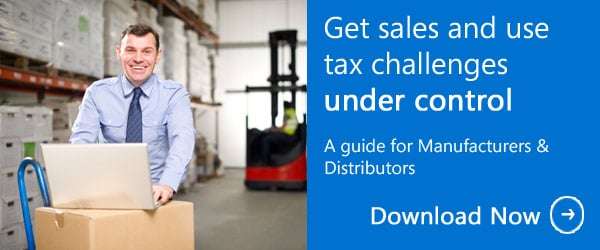
The primary role of a specialized ERP solution, such as Microsoft Dynamics AX, is to integrate all data and processes into a unified system, aiming to boost productivity across supply chain organizations. However, most ERP systems, which have been specially developed to meet certain supply chain requirements, are unable to deal with the core elements of sales tax compliance, such as calculation, collection, reporting, filing and remittance of sales tax.
The best thing you can do to develop a complex system that allows you to run your business efficiently, while ensuring sales tax compliance, is to complement your existing ERP implementation project plan with a sales tax automation solution – a software delivery model, also referred to as SaaS, in which a software product and associated data are hosted on the cloud.
How to Integrate Sales Tax Automation with Your ERP Implementation Project Plan
Sales tax automation solutions have been engineered to perfectly integrate with different software applications, including ERP systems. However, connecting a sales tax SaaS-based model to an ERP system is more difficult than it seems. That’s mainly because you have to consider the compatibility among the particularities of the solutions you're going to use. To help you successfully integrate sales tax automation with an ERP system, here are several best practices.
- Set Your Objectives: Before choosing a specific sales tax SaaS-based solution for your ERP implementation project plan, you have to define your business objectives and timelines. A detailed investigation of current requirements can help you set the right direction not only for subsequent decisions, but also for your organization. Additionally, it’s imperative to consider how sales tax automation and ERP systems are designed to run together; if these systems are able to meet the scalability and security requirements of your business; and whether the end product resulting from the integration of these two systems grants access to multiple users or not. When checking these points, make sure you note everything down in order to get a clear picture of the challenges you may face during the integration process.
- Develop a Robust Strategy: After selecting a particular sales tax automation application for your ERP system, you should create special standards for adopting and integrating the best ERP- and SaaS-based modules across your organization. Once these standards are established, strategic operational planning can be developed to better integrate these solutions with each other.
- Designate the Operations Team: Your operations team should include professionals with engineering, information technology and operational expertise in system and application management, network and security management, deployment and infrastructure design. Only these experts have the necessary knowledge and experience to design a scalable architecture for hosting both ERP and sales tax SaaS platforms.
- Architect a Secure and Reliable Infrastructure: It's imperative to critically examine the key points that can help you build a safe, dependable infrastructure that integrates sales tax automation with ERP implementation project plan. To meet your current and future business demands, the infrastructure you consider deploying should include reliable intrusion detection software devices; efficient load balancers that can streamline a variety of business processes; competent VPN and SSL acceleration units that speed up processes; and multiple data storage options.
The aforementioned practices propose a proven methodology for successfully integrating an ERP solution with a sales tax SaaS-based module. Since there is no substitute for domain expertise, the most critical point to have in place before taking on this challenge is a team of specialists who have previously built and managed such infrastructures.
Reasons to Choose Sales Tax Automation
Connecting your ERP implementation project plan to a sales tax SaaS-based model will deliver a complex solution capable to automatically research, calculate, report, file and remit sales tax, helping you not only to comply with sales and use tax regulations, but also to reduce the hidden costs relating to manual sales tax management, eliminate potential audit risks, increase productivity and improve customer satisfaction. Furthermore, complementing your ERP system with a sales tax automation solution allows you to benefit from important updates without additional costs. At the risk of stating the obvious, all these will have an incredibly positive impact on your profit margin.
Join us this Wednesday, September 11th at 10am CT/ 11am ET for a webinar on Upcoming Sales Tax Changes. Register today
